A Getting around
A رفت و آمد
در این درس قصد داریم انواع روش های رفت و آمد به زبان انگلیسی را بررسی کنیم و توضیح دهیم مردم از چه راه هایی برای جابجایی استفاده می کنند.
لغات کلیدی:
1 Vocabulary Ways of getting around
1 واژگان روش های رفت و آمد
A Listen and repeat.
A گوش دهید و تکرار کنید.
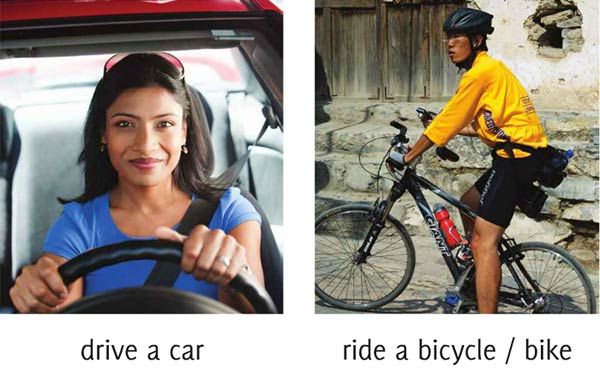
| دوچرخه سواری کردن | ماشین راندن |
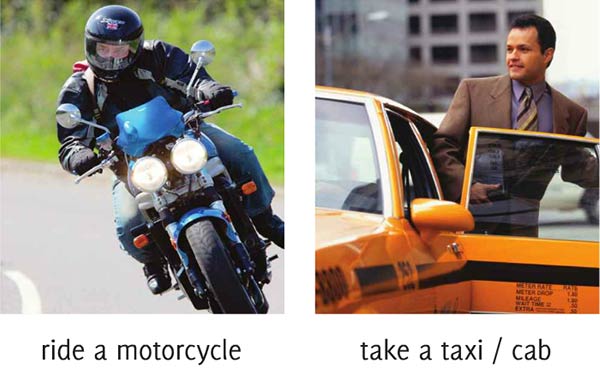
| تاکسی سوارشدن | موتورسواری کردن |
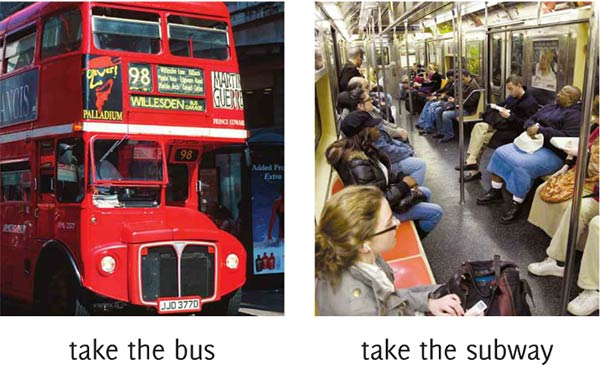
| مترو سوارشدن | اتوبوس سوار شدن |
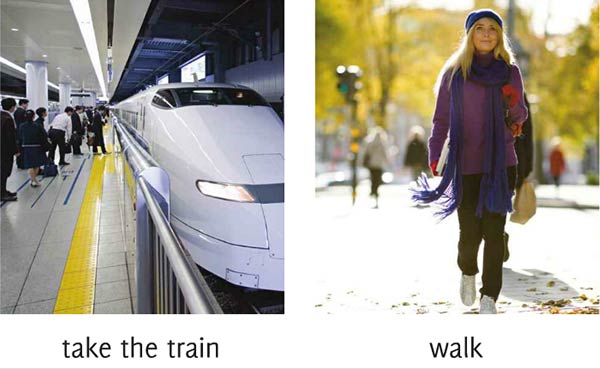
| پیاده روی کردن | قطار سوارشدن |
Script:
متن فایل صوتی:
Unit 4, Daily life, Lesson A, Getting around
Page 36, Exercise 1, Vocabulary, Ways of getting around, Part A
drive a car
ride a bicycle / ride a bike
ride a motorcycle
take a taxi / take a cab
take the bus
take the subway
take the train
walk
B Listen to five ways of getting around. Number them from 1 to 5.
B به پنج روش رفت و آمد گوش دهید. آن ها را از 1 تا 5 شماره گذاری کنید.
a bicycle
a bus
a car
a motorcycle
a train
Answer:
1. a bus
2. a bicycle
3. a motorcycle
4. a car
5. a train
Script:
متن فایل صوتی:
Part B
1. [a bus]
2. [a bicycle]
3. [a motorcycle]
4. [a car]
5. [a train]
2 Language in context Going to work and school
A Listen to Mareila describe how she and her family get to work and school. Underline the ways the get around.
A به توضیحات ماریلا درباره ی اینکه خانواده اش چطور به مدرسه و سرکار می روند گوش دهید. زیر روش های رفت و آمد خط بکشید.

I have a car. I drive to work.
I dont't take the train.
من ماشین دارم. تا سر کار رانندگی می کنم.
سوار قطار نمی شوم.

My husband doesn't drive to work.
He has a bike, so he rides his bike.
شوهر من رانندگی نمی کند.
او یک دوچرخه دارد. تا محل کار دوچرخه سواری می کند.
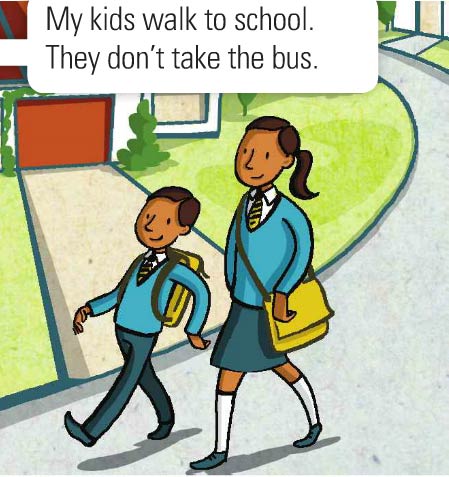
My kids walk to school.
They don't take the bus.
بچه های من تا مدرسه پیاده روی می کنند.
آن ها سوار اتوبوس نمی شوند.
Script:
متن فایل صوتی:
Page 36, Exercise 2, Language in context, Going to work and school
MARIELA: I have a car. I drive to work. I don't take the train.
My husband doesn't drive to work. He has a bike, so he rides his bike to work.
My kids walk to school. They don't take the bus.
B What about you? Check (✔) the ways you get around.
B شما چطور؟ روش هایی که شما با آن رفت و آمد می کنید علامت (✔) بزنید.
- I drive.
- I take the bus.
- I ride a bike.
- I walk.
نکته 1: bike مخفف bicycle است. و cab همان taxi است.
نکته 2: برای bike, bicycle, motorcycle, motorbike از فعل ride استفاده می شود.
نکته 3: برای taxi, cab, bus, subway, train از فعل take استفاده می شود.
در ادامه می آموزیم چگونه با ساختن جملات حالت ساده در مورد نحوه نقل مکان کردن صحبت کنیم.
3 Grammar Simple present statements
3 گرامر زمان حال ساده
| Regular verbs | |
| افعال باقاعده | |
| I drive to work. | I don't take the train. |
| من تا محل کار رانندگی می کنم. | من سوار قطار نمی شوم. |
| You take a taxi. | You don't take the subway. |
| تو تاکسی می گیری. | تو سوار مترو نمی شوی. |
| He rides a bike. | He doesn't drive to work. |
| اون مرد دوچرخه سواری می کند. | اون مرد تا محل کار رانندگی نمی کند. |
| She drives. | She doesn't walk. |
| اون زن رانندگی می کند. | اون زن تا محل کار پیاده روی نمی کند. |
| We take the train. | We don't take a taxi. |
| ما سوار قطار می شویم. | ما تاکسی نمی گیریم. |
| They walk to school. | They don't take the bus. |
| آن ها تا مدرسه پیاده روی می کنند. | آن ها سوار اتوبوس نمی شوند. |
| Irregular verbs | |
| افعال بی قاعده | |
| I / you / we / they | he / she / it |
| من / تو / ما / آن ها | اون مرد / اون زن / اون شیء |
| I have a car. | She has a car. |
| من ماشین دارم. | اون زن ماشین دارد. |
| You don't have a bike. | She doesn't have a bike. |
| تو دوچرخه نداری. | اون زن دوچرخه ندارد. |
| We go to work. | He goes to work. |
| ما سر کار می رویم. | اون مرد سرکار می رود. |
| They don't go to school. | He doesn't go to school. |
| آن ها به مدرسه نمی روند. | اون مرد به مدرسه نمی رود. |
| Contractions (مخفف ها) don't = do not doesn't = does not |
Script:
متن فایل صوتی:
Page 37, Exercise 3, Grammar, Simple present statements
Regular verbs:
I drive to work. / I don't take the train.
You take a taxi. / You don't take the subway.
He rides a bike. / He doesn't drive to work.
She drives. / She doesn't walk.
We take the train. / We don't take a taxi.
They walk to school. / They don't take the bus.
Irregular verbs:
I / you / we / they:
I have a car.
You don't have a bike.
We go to work.
They don't go to school.
he / she / it:
She has a car.
She doesn't have a bike.
He goes to work.
He doesn't go to school.
Contractions:
"don't" equals "do not"
"doesn't" equals "does not"
نکته 1:جملات حال ساده زمانی بکار می روند که در مورد اعمالی صحبت می کنیم که به طور منظم برای مدتی تکرار می شوند. بنابراین برای صحبت کردن و پرسیدن در مورد کارهای روزانه باید از فعل حال ساده در جملات خود استفاده کنیم.
نکته 2: برای ضمایر فاعلی he و she و it در جملات حال ساده باید به آخر فعل s یا es بیفزاییم.
نکته 3: فرمی از فعل have که برای he, she, it بکار می رود، has است.
نکته 4: فعلهای go و have جز افعال بی قاعده هستند.
A Complete the sentences with the simple present forms of the verbs. Then compare with a partner.
A جملات را با شکل درست افعال داخل پرانتز کامل کنید. سپس جواب ها را مقایسه کنید.
- I (take) the bus to school. I (not / walk).
- Jonathan (have) a car. He (drive) to work.
- My parents (take) the train to work. They (go) to the city.
- My neighbor (ride) a motorcycle to work.
- Mei-li (not / take) the bus. She (walk).
- We (not / have) bicycles, and we (not / drive).
Answer:
پاسخ:
1. take - don't walk
2. has - drives
3. take - go
4. rides
5. doesn't take - walks
6. don't have - don't drive
B Pair work Make five sentences about how your family members and friends get to school or work. Tell your partner.
B تمرین دونفره پنج جمله درباره اینکه دوستان و اعضای خانواده تان چطور به مدرسه و سرکار می روند بنویسید. به دوستتان نشان دهید.
A: My sister works in a big city. She takes the bus to work.
B: My best friend works in a big city, too. He doesn't the bus. He drives.
A: خواهر من در یک شهر بزرگ کار می کند. او سوار اتوبوس می شود.
B: دوست صمیمی من هم در یک شهر بزرگ کار می کند. او سوار اتوبوس نمی شود. او رانندگی می کند.
4 Speaking I take the bus.
4 صحبت کردن من سوار اتوبوس می شوم.
A Write how you get to school or work in the chart. Add extra information, such as a bus number or a train number.
A توضیح دهید چگونه به مدرسه یا محل کار می روید. اطلاعاتی همچون شماره قطار یا اتوبوس را هم به آن اضافه کنید. می توانید از مکالمه زیر کمک بگیرید:
| A: I take the bus to school. I don’t drive. How about you? |
| A: من تا مدرسه سوار اتوبوس می شوم. رانندگی نمی کنم. تو چی؟ |
| B: I don’t drive. I take a cab. My brother drives to work. |
| B: من رانندگی نمی کنم، تاکسی می گیرم. برادرم رانندگی می کند. |
| A: My father doesn’t take a taxi. He rides a bike. How about your father? |
| A: پدر من تاکسی نمی گیرد. او دوچرخه سواری می کند. پدر تو چطور؟ |
| B: He takes the bus. It’s the number 8 bus. |
| B: او سوار اتوبوس می شود. اتوبوسش شماره 8 است. |
| Me | Name: | Name: | Name: | |
| To school | ||||
| To work | ||||
| Extra information |
B Group work Find out how three of your classmates get to school or work. Complete the chart with their information.
B تمرین گروهی درباره نحوه ی رفت و آمد سه نفر از همکلاسی هایتان اطلاعات جمع آوری کنید. جدول را به کمک اطلاعاتشان کامل کنید.
A: I take the bus to school. It's the number 16 bus. How about you?
B: I take the bus, too. I take the number 8 bus.
A: من با اتوبوس به مدرسه می روم. اون اتوبوس شماره 16 است. تو چطور؟
B: من هم سوار اتوبوس می شوم. من سوار اتوبوس شماره 8 می شوم.
C Group work Tell another group how your classmates get to school or work.
C تمرین گروهی به گروه دیگر بگویید چطور هم گروهی هایتان به مدرسه یا سرکار می روند.
"Daniel takes the number 8 bus to school."
"دنیل با اتوبوس شماره 8 به مدرسه می رود."
به این ترتیب شما به راحتی می توانید در مورد نحوه رفت و آمد خود در سطح شهر به زبان انگلیسی گفتگو کنید.
I can describe how people get around.
من میتوانم درمورد رفت و آمد افراد صحبت کنم.
در صورتی که سوالی دارید و یا بخشی از درس برایتان مبهم است می توانید در بخش (افزودن دیدگاه جدید) آن را مطرح کنید.
12 دیدگاه ارسال شده:
در بخش گرامر مثلاً نوشته برای
در بخش گرامر مثلاً نوشته برای bus از فعل take استفاده میشه. حالا میشه به جای این فعل در جمله از فعل go یا رفتن استفاده کنیم و قبل از bus از حرف اضافه ی by استفاده کنیم؟
"I take a bus." or "I go to work by bus"
و اگه بخوایم بگیم پیاده میرم میشه به جای walk از foot استفاده کنیم؟
I walk to school.
I go to school on foot.
- برای ارسال دیدگاه وارد شوید.
دقیقاً همینطوره و همه ی جملات
دقیقاً همینطوره و همه ی جملات شما صحیحه. این درس یکی از 200 درس دوره ی آموزشی Four Corners هست که شما رو با روش های رفت و آمد آشنا میکنه. طبیعتاً جورهای دیگه هم میشه این جملات رو بیان کرد. طبیعتاً شما این فرم ها رو در درس های دیگه خواهید دید. همونطور که در فارسی میگیم:
- با اتوبوس رفتم.
- اتوبوس گرفتم.
- از اتوبوس استفاده کردم.
- پیاده رفتم.
- راه رفتم.
- با پاهام رفتم!
و شاید فرم های دیگه که به ذهن من نمیاد، در انگلیسی هم برای بیان هر function یا کاربرد، فرم های مختلفی وجود داره. بخش function و form سایت با نام کاربرد های زبان در حال تکمیل شدن هست که میتونید از اون طریق متوجه بشید که مثلاً برای موافقت یا مخالفت کردن چه جمله هایی به کار میره. دیکشنری Longman Activator یک مرجع عالی برای سوال شماست. این دیکشنری در مورد فعل هایی که برای جابه جا شدن به کار میره میگه:
different ways of travelling
drive / draɪv / [ intransitive verb ] to travel in a car :
▪ ‘How are you going to get there?’ ‘I’m driving.’
drive to/from
▪ Jenny drove to the coast for the weekend.
fly / flaɪ / [ intransitive verb ] to travel by plane :
▪ My mother never liked flying.
fly to/from etc
▪ We’ll be flying from New York to Munich.
sail / seɪl / [ intransitive verb ] to travel by boat or ship :
▪ We sail first thing in the morning
sail to/from
▪ He sailed from Southampton on May 6th.
by car/boat/plane/train / baɪ ˈkɑːʳ, ˈbəʊt, ˈpleɪn, ˈtreɪn / [ adverb ] travelling in a car, boat, plane, or train :
▪ ‘Did you come by car?’ ‘No, by train.’
▪ Some of the beaches can only be reached by boat.
▪ We didn’t have much time, so we decided to go by plane.
on foot / ɒn ˈfʊt / [ adverb ] if you go somewhere on foot , you walk there :
▪ The two men had attempted to cross the mountains on foot.
take / teɪk / [ transitive verb ] if you take a train, bus, or plane, you travel in it :
▪ What’s the best way to get downtown? Should I take a bus?
▪ Take the subway to Montgomery Station and walk from there.
by air/by sea/by land / baɪ ˈeəʳ, baɪ ˈsiː, baɪ ˈlænd / [ adverb ] if you travel by air , by sea , or by land you travel by plane, in a boat, or on land :
▪ It’s much quicker if you go by air, but it’s also more expensive.
▪ Troops entered the region by land and sea.
overland / ˌəʊvəʳˈlænd◂ / [ adverb ] by train, car, bus etc, especially over a long distance, when people would normally go by plane or ship :
▪ It’s certainly quicker to fly but we thought it would be more exciting to go overland.
overland [ adjective only before noun ]
▪ The overland route is very difficult at times.
hitchhike/hitch also hitch a ride American / ˈhɪtʃhaɪk, hɪtʃ, ˌhɪtʃ ə ˈraɪd / [ intransitive/transitive verb ] to travel by standing by the side of the road asking people in cars to stop and take you to the place you want to go :
▪ He lost all his money in a casino in Vegas and had to hitchhike back to San Francisco.
▪ We hitched a ride with a trucker who took us all the way to the Virginia border.
▪ It’s a lot cheaper to hitch but it’s also more dangerous.
backpacking / ˈbækˌpækɪŋ / [ uncountable noun ] the activity of travelling independently to a lot of different areas, carrying your clothes etc in a special bag on your back :
▪ Backpacking is especially popular among students and young people.
▪ a backpacking trip
go backpacking
▪ Last year, he went backpacking in the US.
Longman Language Activator
- برای ارسال دیدگاه وارد شوید.
خیلی ممنون از پاسخ کامل و
خیلی ممنون از پاسخ کامل و جامع شما و همینطور برای زحمات شبانه روزی شما و تیم لنگوئج تایز.
بیصبرانه منتظر تکمیل بخش کاربردهای زبان هستم.
بهترین ها رو براتون آرزو دارم. :گل :)
- برای ارسال دیدگاه وارد شوید.
فقط میتونم بگم فوق العاده است
فقط میتونم بگم فوق العاده است.
موفق باشید.
- برای ارسال دیدگاه وارد شوید.
شما هم فوق العاده اید! خیلی
شما هم فوق العاده اید! خیلی ممنون!
- برای ارسال دیدگاه وارد شوید.
A: I take the bus to school.
A: I take the bus to school. It's the number 16 bus. How about you?
B: I take the bus, too. I take the number 8 bus.
- برای ارسال دیدگاه وارد شوید.
I drive to office but I ride
I drive to office but I ride a bike to school.
- برای ارسال دیدگاه وارد شوید.
ممنون از پیاده سازی مطالب
ممنون از پیاده سازی مطالب آموزشی به این نحو ![]() واقعا مفید وخلاصه شدست مطالبتون.
واقعا مفید وخلاصه شدست مطالبتون.
- برای ارسال دیدگاه وارد شوید.
سلام لطفا به فارسی روش ساخت
سلام لطفا به فارسی روش ساخت جمله به زبان حال ساده رو توضیح دهید و انواع روش ها و مثالم بزنید مثلا اول فاعل بعد فعل و ممنون میشم
- برای ارسال دیدگاه وارد شوید.
گرامر زمان حال ساده در زبان
گرامر زمان حال ساده در زبان انگلیسی را میتوانید بطور کامل مطالعه کنید.
- برای ارسال دیدگاه وارد شوید.
بسیار عالی بود ممنون از زحمات
بسیار عالی بود ممنون از زحمات شما
- برای ارسال دیدگاه وارد شوید.
